Archive for December 2007
An Aya Uto Christmas: Silent Night and Christmas Cake
"Super Idol" singer and actress Aya Ueto sings Silent Night for a Softbank cell phone commerical. Don't miss the classic Japanese Christmas cake at the end!
As an American raised in a predominantly ethnic Italian influenced family, I had never heard of "Christmas cake" before traveling to Japan. I'm interested in knowing which cultures celebrate Christmas with cake. Please share your traditions with us in the comment section!
"Tokyo Sanka" English Translation: 東京賛歌 : Bump of Chicken
Bump of Chicken = Best Japanese band. EVER.
*****
Tokyo Hymn (Tokyo Sanka)
It's a town with sky and earth
How is it different from the town where you grew up, I wonder?
Why can you tell the difference, I wonder?
I guess you've been taught since you came here
Things like all the lies, the cold, not being able to see the stars,
A storm of troubles
It's the revenge of things not going well, I guess
You started and quit so many here
What was it that you came here to do?
For whose sake was it?
Roads and railroad tracks are connected but... that's so but...
Jump out as you please, struggle along as you please
This town is all that you know
The drawer of your abandoned dream
Back then they were always nearby
The people you hate and like
Nowadays, do you care?
I guess you realized since you came here
No matter where a person goes
They are same as always
Separated from somebody and separated from yourself
You're alive!
Chosen as you please, hated as you please,
This town is all you have
The place where you, who can't go home, are
There are lots of lies everywhere, don't you think?
After all, when you can see the stars, you lose interest, right?
Among all the people passing one another by,
I think there are more than a few who came here
For similar reasons
What was it that you came here for?
Who was it that decided?
The earth and the sky are connected
The future and the past,too
You jumped out as you pleased, struggle along as you pleased
This town is all you know
The continuation of the dream you got back
Chosen as you please, hated as you please
This town is all you have
The place where you, who can’t go home, are
This town is all you have
The way back home to the place you grew up…
Jidai Matsuri 2007: Abutsu Ni
 The geiko Mao of Gion Kobu peeks out from beneath her uchikatsugi as Madame Fujiwara Tamie, also known as Abutsu Ni, in Kyoto's famous Festival of Ages.
The geiko Mao of Gion Kobu peeks out from beneath her uchikatsugi as Madame Fujiwara Tamie, also known as Abutsu Ni, in Kyoto's famous Festival of Ages.
Jidai Matsuri 2007: Momoyama Period Style
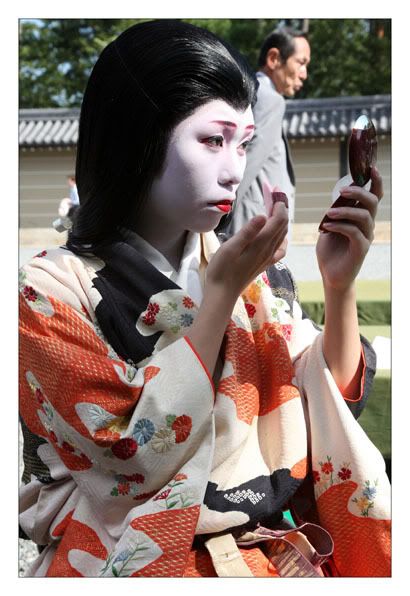
Yukako, maiko of Gion Kobu, makes a few last touches to her makeup before the procession begins.
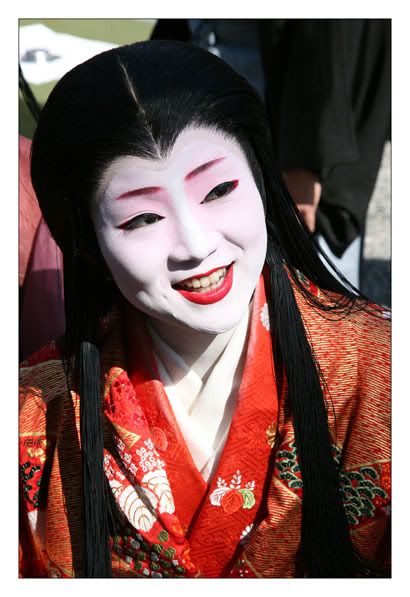
The geiko Suzuko flashes a stunning smile as Yodogimi, a favorite concubine of Toyotomi Hideyoshi.
 Makiko, maiko of Gion Kobu, also served as a Lady-in-Waiting to Yodogimi (Suzuko).
Makiko, maiko of Gion Kobu, also served as a Lady-in-Waiting to Yodogimi (Suzuko).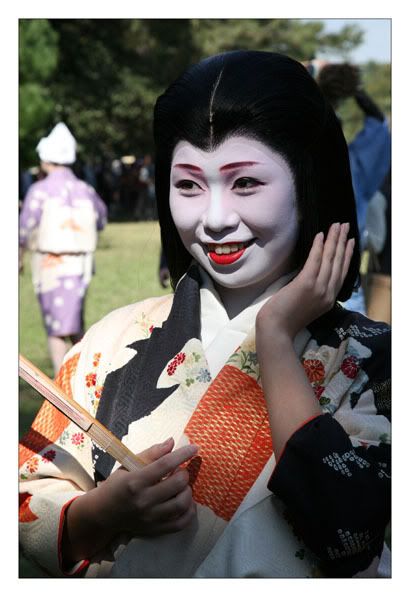
Yukako smiles sweetly as she chats with friends.
 Sakiko, another young maiko of Gion Kobu, shades herself with an elaborate fan.
Sakiko, another young maiko of Gion Kobu, shades herself with an elaborate fan.
Kojima Yoshio : English Teacher!
Comedian Yoshio Kojima trys his hand at teaching English...
**************************
Woman: (Hoping for help from Kojima, she reads him her homework)
Kojima: Wow, you're horrible! That's not even close!
Woman: It's been so long since I read English...
Kids: Well then, you read it!
Kojima: Shall I read it for you? That's not smooth at all, and there's so much space between the words foreigners will never understand you!
Woman: Well then, Mr. Kojima, if you would, please...
Kojima: (Brilliant English-- no translation needed!)
Woman: What language is that?
Kojima: It's English!!!
♪♪♪ Acutally I can't read English、but that doesn't matter! ♪♪♪
Hai, OPPAPI!
*(Note: Oppapi supposedly stands for "Ocean Pacific Peace". Does that explanation sounds dubious to anyone else?)
...And Japanese!
Kojima attempts to help a young boy learn a kanji, or Chinese character...
Koijima: This is the character "naku", "to cry," Ok?
Boy: Naku (to cry).
Kojima: Naku. To Cry. This is easy. Umm... (baby cries) will you be quiet? Uh... first, WHOA! Don't pull my undies down, OK?! That's dangerous!
(Begins to draw) This is a crying... Do you got it? It's a crying person. Crying. He is crying. Crying. Cryin'. Cry crai cra crr cr... CRYING!
(Kojima shows the progression of the kanji from picture to pictograph)
Boy: I still don't quite understand...
Kojima: You still don't understand? Ok, but this is how I got into Waseda...
Wow. When you explain kanji like that, it really starts to make sense! I bet naku is one kanji that boy will never forget.
Much thanks to Japan Probe for always bringing the best of Japanese TV to the blogsphere, and for being a much cooler blog than this will ever be. m(- -)m
Jidai Matsuri 2007 : Yokobue
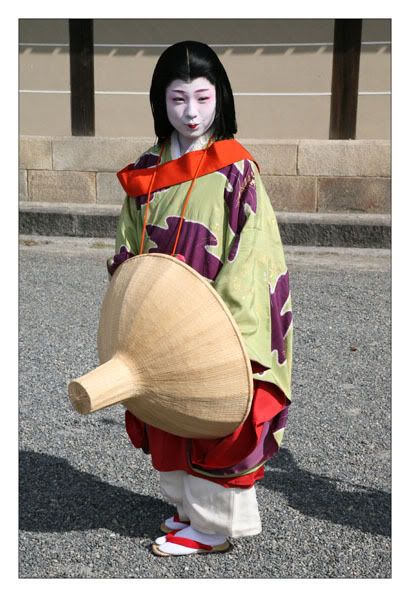
Komomo, geiko of Miyagawa-cho, as Yokobue.
A low-ranking lady-in-waiting, Yokobue fell in love with Takiguchi-no-Tokiyori, a warrior of the Imperial Palace. The first time Tokiyori saw Yokobue dance at a hanami party he decided at once that he wanted her for his wife. When his family rejected her, the warrior sought solace by becoming a priest. Yokobue traveled to see Tokiyori, but he refused to meet her because he had already taken his vows. Stricken with grief, Yokobue drowned herself (as many Japanese heroines are rumored to have done). Before leaving, she wrote her true feelings in her own blood on a rock still standing before the gate of Takiguchi-dera, on the same site where Tokiyori took refuge so long ago.

Jidai Matsuri 2007: Ono No Komachi
Heian Period Women
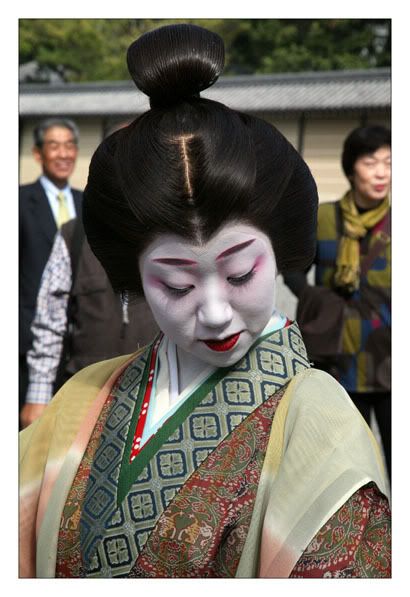
Fukuaya, geiko of Miyagawa-cho, as Ono no Komachi.
Immortalized as one of the best waka poets of her day and a rare beauty, Ono no Komachi is Japan's earliest and best example of a passionate woman poet. Although they were written over a thousand years ago and can be read in a matter of minutes, the handful of her verses that survive today have been celebrated and studied for centuries, transcending time and culture to move and inspire people all around the world.
One of her poems is also included in the Hyakunin Isshu, a famous anthology of waka poetry also used in uta-garuta.
花の色は
The hue of the cherry blossoms
have faded
Gazing meaninglessly
at the long rain,
I grow old
It may be hard to fully appreciate Japanese poetry without an understanding of the subtle puns and play of words lost in translation. In the poem above, Komachi uses the word furu to connect the idea of growing old to the falling of the rain, and the word nagame to the idea of gazing to the long rains.
Here are a few of my favorite Komachi poems:
Although my feet never cease running to you
On the path of dreams,
The sum of all those meetings
Is less than a single waking glimpse.
******
Did he appear
Because I fell asleep
thinking of him?
If only I'd known I was dreaming
I never would have wakened.
The autumn night
is long only in name
We've done no more
than gaze at each other
and it's already dawn
*****
Yeilding to a love
That knows no limit,
I shall go to him by night--
For the world does not yet censure
Those who tread the paths of dreams
You can read all 22 of her surviving poems here. Which is your favorite?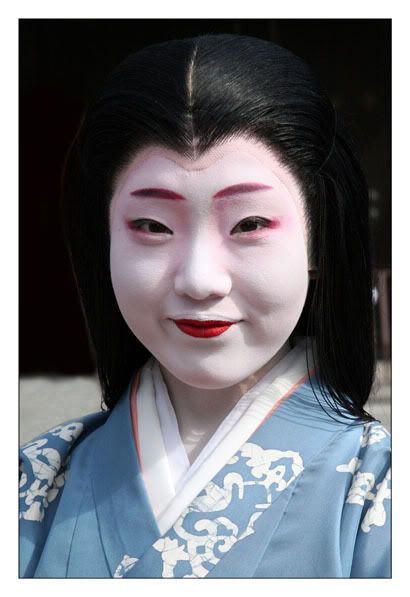
Fukunami, a young geiko of Miyagawa-cho, dressed as a lady-in-waiting to Ono no Komachi.










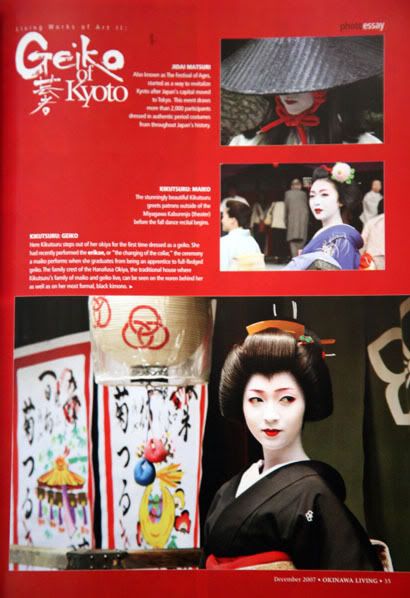
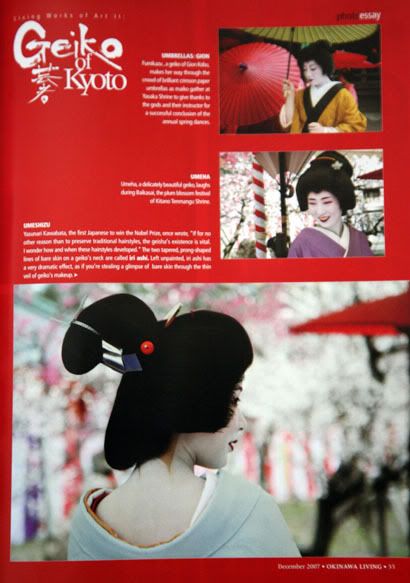
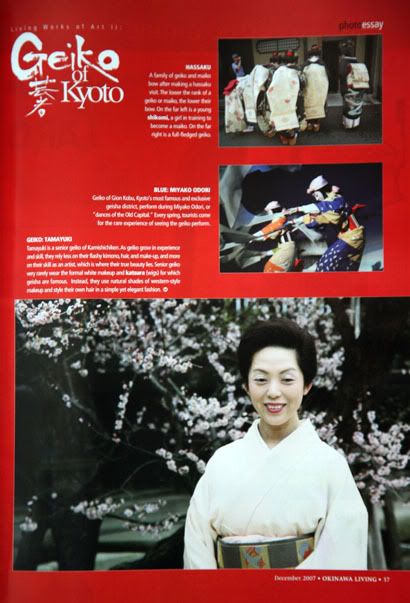
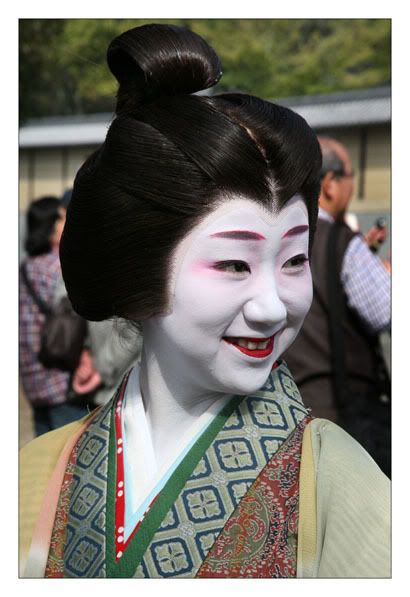


Nengajo: Japanese New Year's Cards
A brilliant up and coming graphic designer in Tokyo, Yuki Nakano designed this nengajo to welcome 2008: The Year of the Rat. The design of most nengajo includes the junishi, or Oriental zodiac animal, of the New Year.
Oshogatsu, or New Year's, is a very special time in Japan—a time for people return to their ancestral homes, spend time with their families and get in touch with their roots. Perhaps the most honored and celebrated of the Japanese holidays, Oshogatsu is a three-day event beginning with Omisoka (New Year's Eve) and lasting through the first three days of the year. Many people wear traditional clothing, like kimono, and play traditional games, such as uta garuta. Preparations begin long in advance as people clean their homes from top to bottom (known as Osouji), prepare Osechi ryori (traditional New Year's food eaten during the forst three days of the new year), and write nengajo, or New Year's greetings.
These days, many people use designs including photos of themselves or their families on their nengajo.
Much like the Christmas cards exchanged in the US and abroad, nengajo are an important part of Japan's New Year's festivities. Now an established tradition, the exchange of these New Year's greetings began in 1873, when postcards were first introduced to Japan. Today, the average family sends over a hundred nengajo to family, friends and colleagues, and businesses mail them to all their customers.
New Year's is a time for wafuku (traditional Japanese clothing) and Osechi ryori, traditional Japanese New Year's food.
Of course, if you are a card-carrying gaijin, you are theoretically exempt from all of these rules. Why not surprise your friends and colleagues with your astounding nengajo knowledge and skill? The same gracious people that praise your ability to use chopsticks and poor attempts at speaking Japanese will be thrilled with the thoughtful consideration and effort, regardless of when your nengajo arrives.
Hand drawn by one of my students, this was the first nengajo I recieved in Japan.
Happy New Year, everyone! ☆明けましておめでとう☆